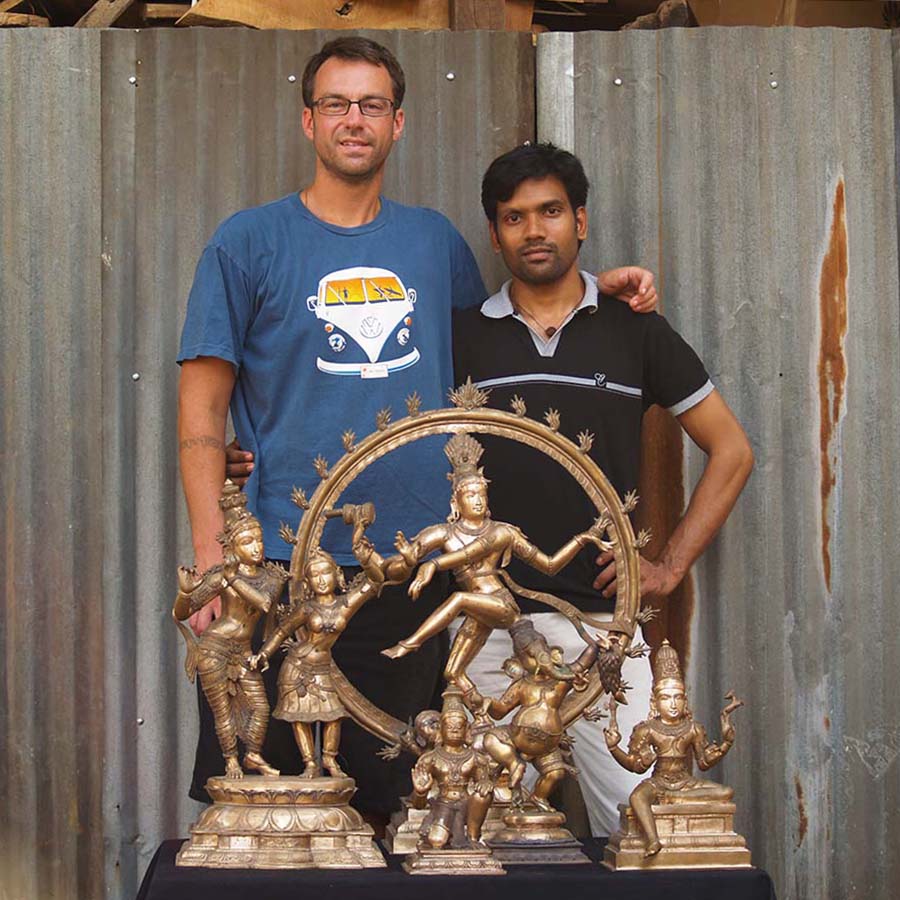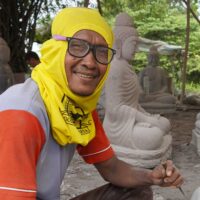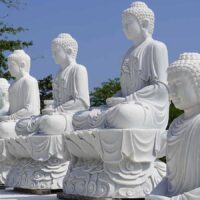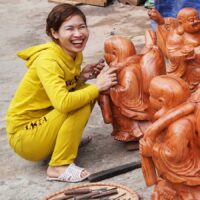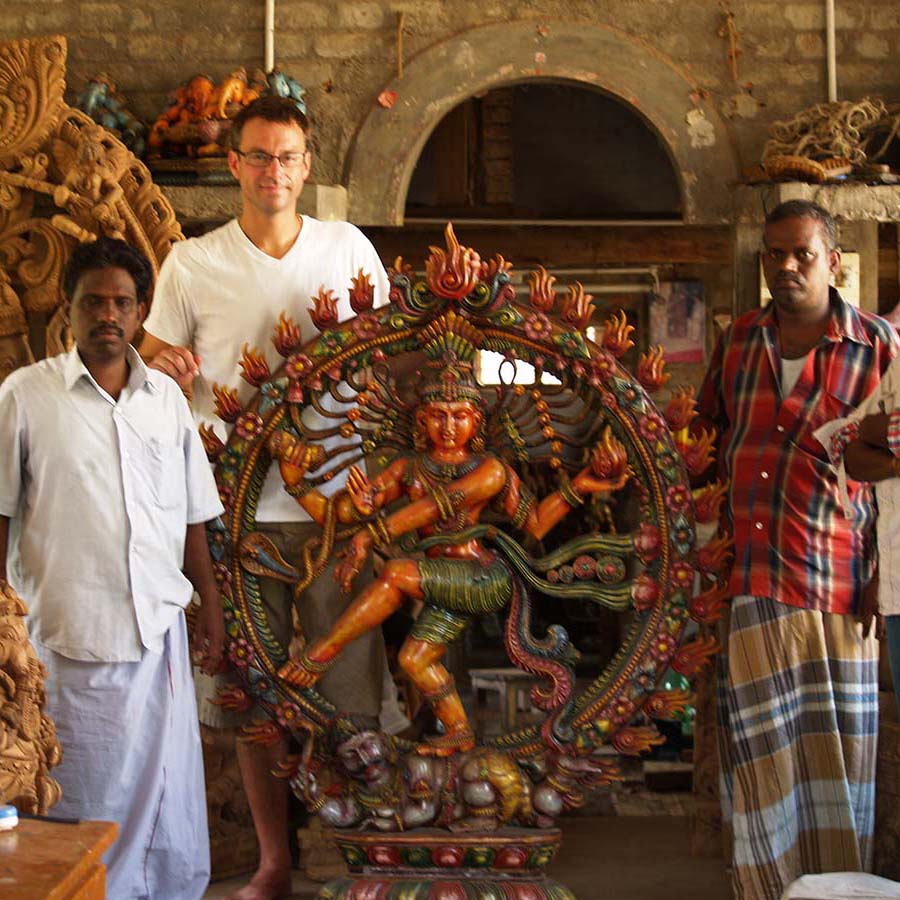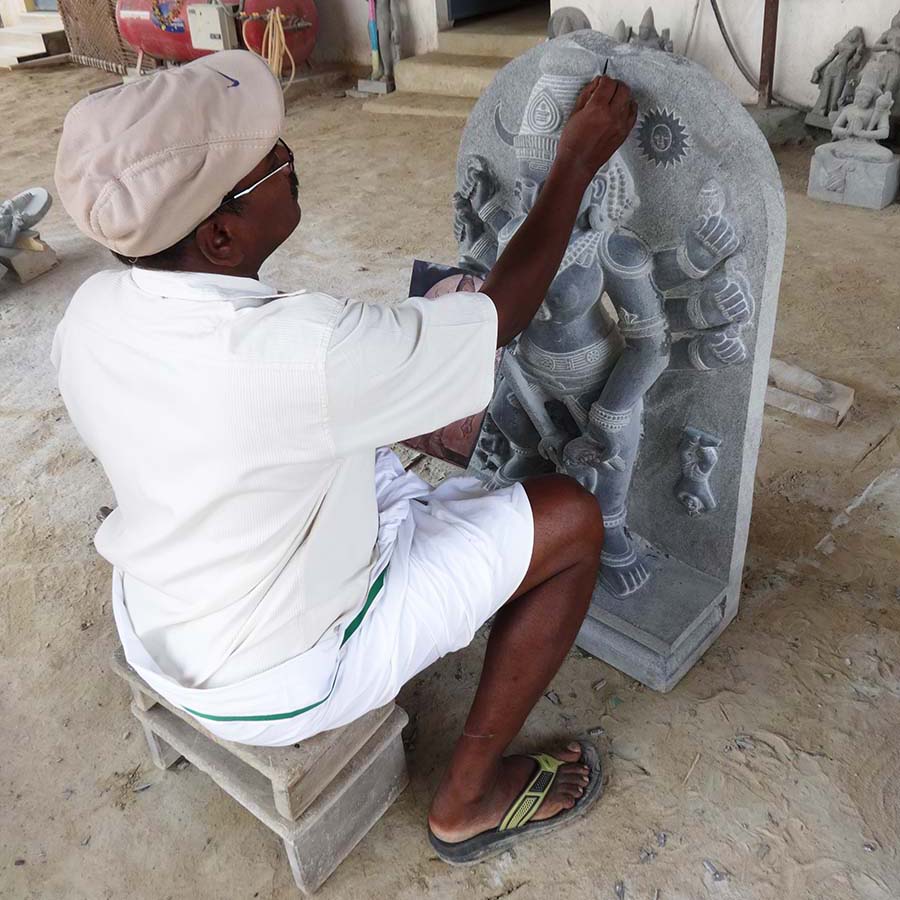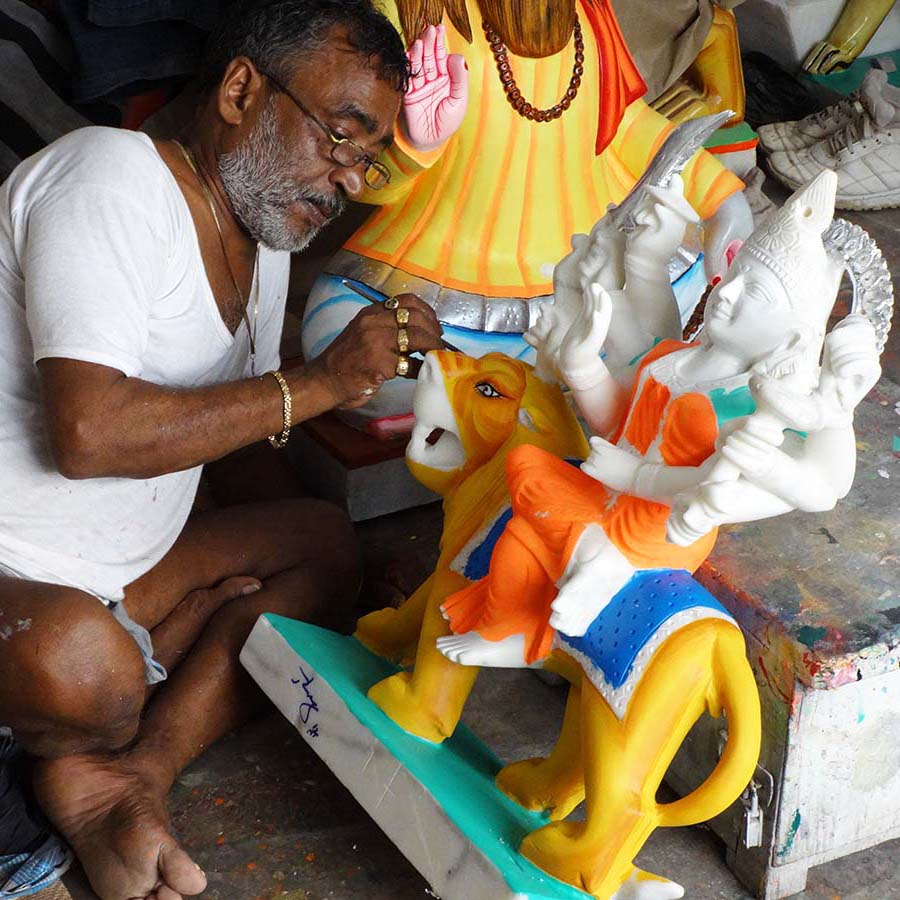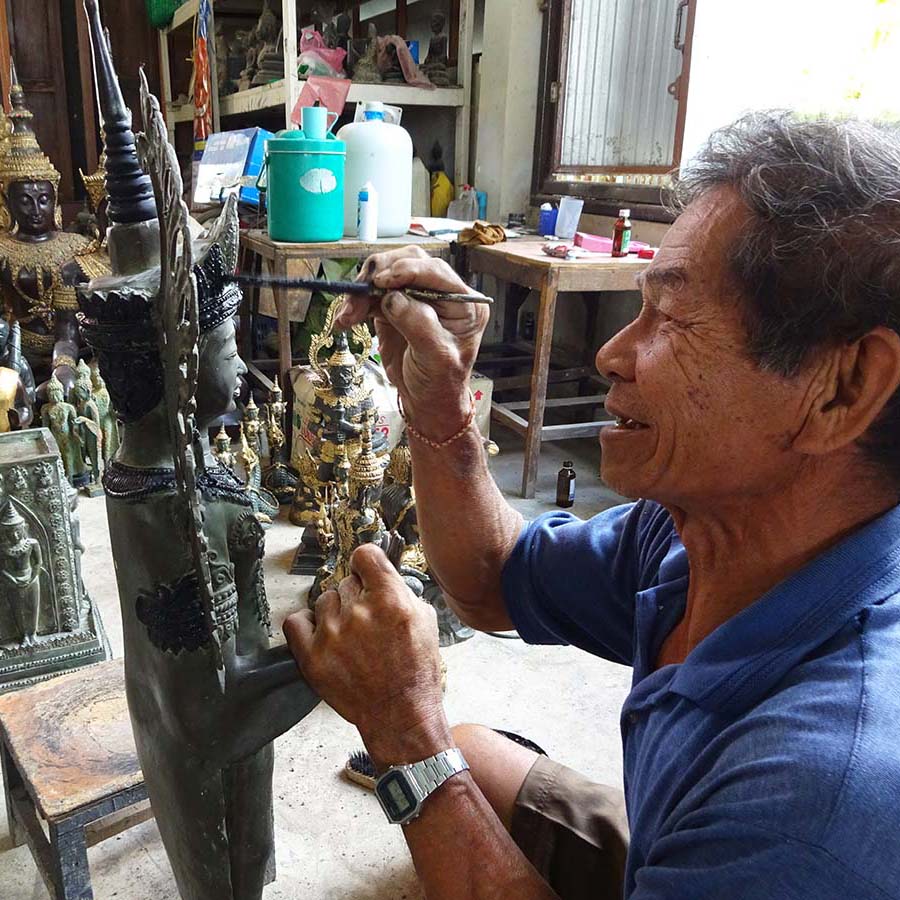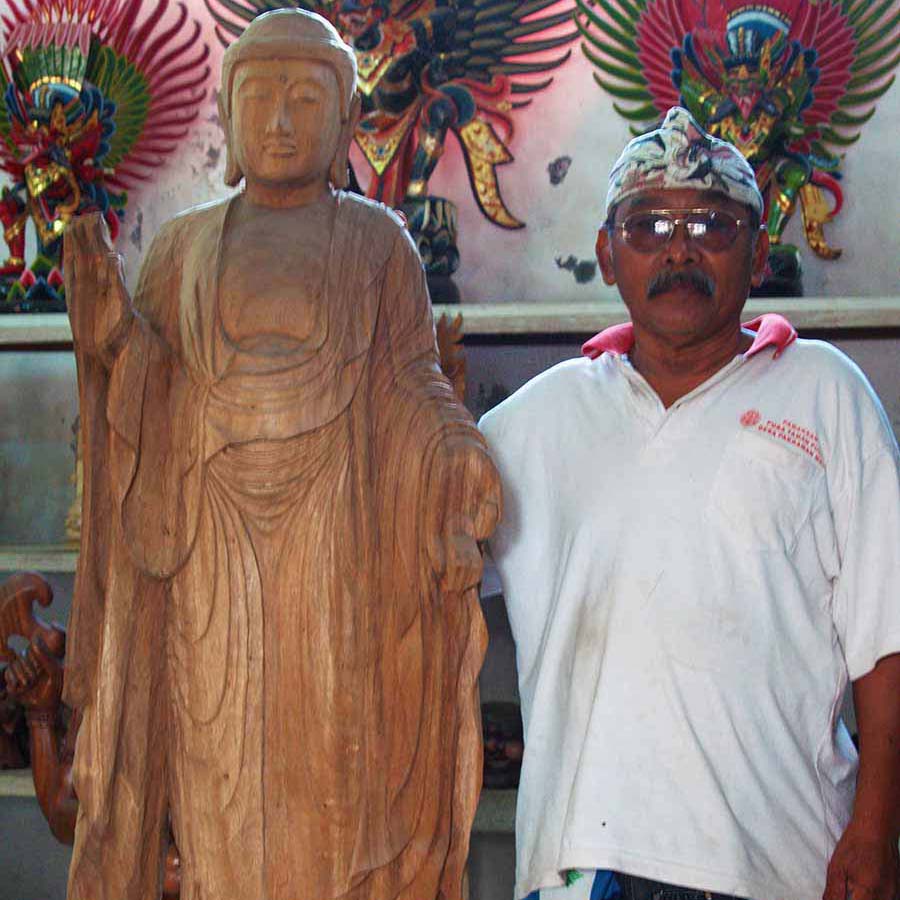Pictures of Our Artisans
I have had a deep love for Asia and its people since my first trip to meditate in a Northern Thailand monastery when I was 18 years old. When I started Lotus Sculpture in 2000 that connection with Asia has blossomed into pure love! I have known many of our artisans since my very first buying trip in 2000 when the new adventure of Lotus Sculpture just started. Together, the relationships I have with my artisans has grown through the years and they are now like my second family. I take great pride in knowing personally almost all the artisans who make the statues sold in Lotus Sculpture. I invite you to join me on my journey through the remote villages where each statue is made and to meet the artisans who create the sculptures that enrich your homes, temples and lives with grace.
Indian Bronze Artists
Lotus Sculpture started exclusively selling South Indian, lost wax method bronzes. My oldest and dearest artisans are Varadaraj and his two brothers, Suri and Muthu who are responsible for creating the majority of bronze sold at Lotus Sculpture. I was always drawn to the difficult and time consuming process of lost wax casting where bronze statues, known as murtis, can take months and sometimes over a year to create. With India’s push to modernize and higher paying jobs being offered in other fields, young apprentices are not taking up the torch to be the next generation of bronze artisans. Lotus Sculpture has provided a beacon of light to the bronze industry. I have directly seen the impact Lotus Sculpture has had on the bronze industry in the small town of Swamimalai where temple bronzes have been made since Chola times by infusing a new demand into the small industry not seen before. For this I thank you, the customers of Lotus Sculpture, and with each trip to India I hear my artisans and their families also thanking you!
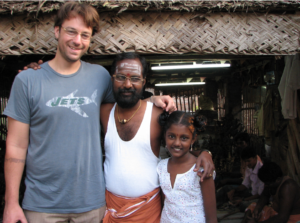 This photo is from 2005. I used to buy a lot of statues through Suri but he couldnt support his family with just me alone so he started another business. I no longer work with him. Sad, but a great example of how this art is dying without support.
This photo is from 2005. I used to buy a lot of statues through Suri but he couldnt support his family with just me alone so he started another business. I no longer work with him. Sad, but a great example of how this art is dying without support.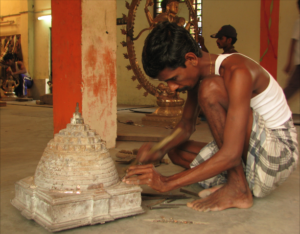 An artist files off the excess bronze from a large Mahamehru statue that will be placed in a Hindu temple. The worship of Devi in Srichakra is regarded as the highest form of the Devi worship.
An artist files off the excess bronze from a large Mahamehru statue that will be placed in a Hindu temple. The worship of Devi in Srichakra is regarded as the highest form of the Devi worship.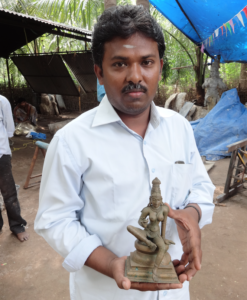 The artist, Ragavanantham holds a Bogashakti that his collective has produced.
The artist, Ragavanantham holds a Bogashakti that his collective has produced.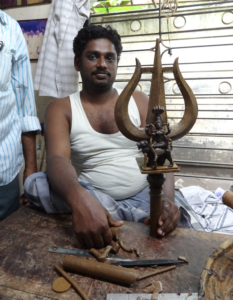 The eldest son of Muthu, Sivan, sits in front of a completed wax model of a trident with the goddess Durga on it.
The eldest son of Muthu, Sivan, sits in front of a completed wax model of a trident with the goddess Durga on it. A bronze artists carves the final details of the eyebrows into a Narasimha statue.
A bronze artists carves the final details of the eyebrows into a Narasimha statue. The wax artists often use hot tools to smooth out the wax. Here they are using a hot file to smooth down the dwarf that Nataraja is dancing upon.
The wax artists often use hot tools to smooth out the wax. Here they are using a hot file to smooth down the dwarf that Nataraja is dancing upon. The three workers surrounding Varadaraj in the red shirt are all workers who are in charge of the actual casting process of first, covering each wax mold in an earthen mold, the firing the mold, bronze and then breaking the mold off from the casting.
The three workers surrounding Varadaraj in the red shirt are all workers who are in charge of the actual casting process of first, covering each wax mold in an earthen mold, the firing the mold, bronze and then breaking the mold off from the casting. Carving out the earthen mold from a bronze statue after casting. Next he will clean the piece and start carving the details.
Carving out the earthen mold from a bronze statue after casting. Next he will clean the piece and start carving the details. The south Indian artist, Selvam posing in front of his most recent Dancing Shiva bronze creation
The south Indian artist, Selvam posing in front of his most recent Dancing Shiva bronze creation Wax artists in the collective of Varadaraj all work together at the same table in a communal fashion each helping each other out with the wax model they are working on.
Wax artists in the collective of Varadaraj all work together at the same table in a communal fashion each helping each other out with the wax model they are working on. This artist specializes in the wax molds of Nataraja statues. He is caught in a moment deciding what dancing Shiva needs next.
This artist specializes in the wax molds of Nataraja statues. He is caught in a moment deciding what dancing Shiva needs next.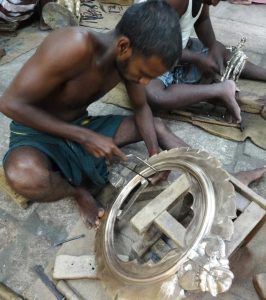 An artist files extra bronze from the arch of Ayyappan. I love the cacophony of sound of the workshop with constant filling and hammering on metal!
An artist files extra bronze from the arch of Ayyappan. I love the cacophony of sound of the workshop with constant filling and hammering on metal!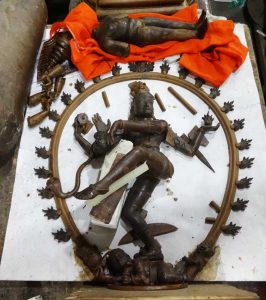 A wax model of a Nataraja with a Bhairava above it. You can see the extra thick line on the face of Nataraja. This is so that after firing, the artist who carves the face, has extra metal to carve a beautiful nose.
A wax model of a Nataraja with a Bhairava above it. You can see the extra thick line on the face of Nataraja. This is so that after firing, the artist who carves the face, has extra metal to carve a beautiful nose. A wax model artist in Muthu's workshop sticks his hand into the fire with a piece of wax to heat it up to make it malleable.
A wax model artist in Muthu's workshop sticks his hand into the fire with a piece of wax to heat it up to make it malleable.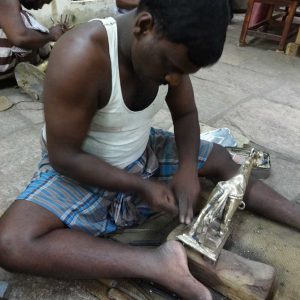 The most laborious part of the process is the filling of the sculpture. This removes all excess bronze and requires hours of hard labor to make every inch of surface on the statue smooth & ready for the carving of finer details.
The most laborious part of the process is the filling of the sculpture. This removes all excess bronze and requires hours of hard labor to make every inch of surface on the statue smooth & ready for the carving of finer details.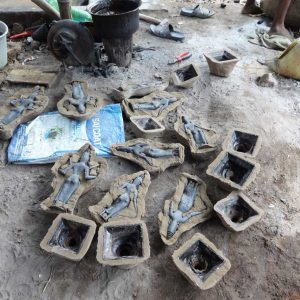 The wax molds are covered in an earthen mold before the firing process. One side is done at a time as you can see here by the backside of each wax model waiting to be completely covered.
The wax molds are covered in an earthen mold before the firing process. One side is done at a time as you can see here by the backside of each wax model waiting to be completely covered.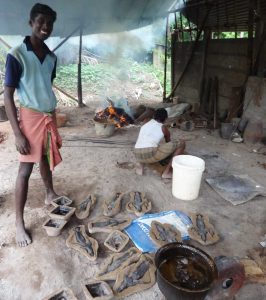 A young apprentice who is learning the complete lost wax method must first start at the bottom and coat the bronze in their earthen molds and be in charge of the firing process
A young apprentice who is learning the complete lost wax method must first start at the bottom and coat the bronze in their earthen molds and be in charge of the firing process Dung patties from local cows are a cost effective way to melt the wax out their earth molds
Dung patties from local cows are a cost effective way to melt the wax out their earth molds Carving a Madurai Veeran statue for a local temple
Carving a Madurai Veeran statue for a local temple Carving the finer details of Parvati in the bronze workshop of Muthu
Carving the finer details of Parvati in the bronze workshop of Muthu The bronze artist is carving away the excess bronze from a statue of Ayyappan
The bronze artist is carving away the excess bronze from a statue of Ayyappan These 3 artisans are friends and are always working side by side on their respective statue sharing carving tools that are spread out around them.
These 3 artisans are friends and are always working side by side on their respective statue sharing carving tools that are spread out around them. All the bronze artists eat together for both lunch and dinner at the workshop of Varadaraj
All the bronze artists eat together for both lunch and dinner at the workshop of Varadaraj The artist, Selvan, is applying the final layer of mud (totaling 5 layers) to the outside of his Nataraja statue prior to putting it in the fire to melt the wax out.
The artist, Selvan, is applying the final layer of mud (totaling 5 layers) to the outside of his Nataraja statue prior to putting it in the fire to melt the wax out. Siva and I in the store room where they keep statues they are working on. He is holding one of the 108 poses of Lord Shiva's Tandava dance. I always wanted to commission a complete set of the 108 poses.
Siva and I in the store room where they keep statues they are working on. He is holding one of the 108 poses of Lord Shiva's Tandava dance. I always wanted to commission a complete set of the 108 poses. The wax modelers all sit at a table around a small fire with warmed wax and heated tools. They use the fire to warm up the wax of what they are working on so that they can easily shape it.
The wax modelers all sit at a table around a small fire with warmed wax and heated tools. They use the fire to warm up the wax of what they are working on so that they can easily shape it. Varadraj's family always invites me to their home for a lunch. This was the first time I met his wife, to my right. His lovely mother's cooking is always the culinary highlight of my trip!
Varadraj's family always invites me to their home for a lunch. This was the first time I met his wife, to my right. His lovely mother's cooking is always the culinary highlight of my trip!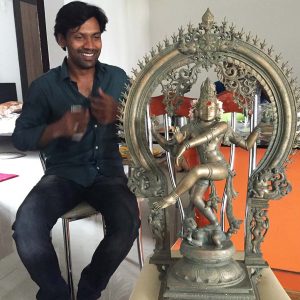 Varadaraj with a Nataraja statue I commissioned from him to make for Lotus Sculpture. He liked it so much he kept it in his house to do daily puja to Lord Shiva!
Varadaraj with a Nataraja statue I commissioned from him to make for Lotus Sculpture. He liked it so much he kept it in his house to do daily puja to Lord Shiva! The paraffin or wax is left on a low fire to keep it malleable so the wax model artists can use use the pliable wax to create their designs
The paraffin or wax is left on a low fire to keep it malleable so the wax model artists can use use the pliable wax to create their designs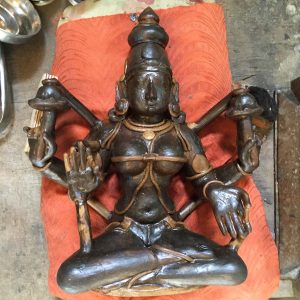 A wax model of Lakshmi! You can plainly see the nalis that act as a conduit between the hard to reach areas of the statue, like the hands, to promote the liquid bronze to flow to every area of the statue during casting.
A wax model of Lakshmi! You can plainly see the nalis that act as a conduit between the hard to reach areas of the statue, like the hands, to promote the liquid bronze to flow to every area of the statue during casting.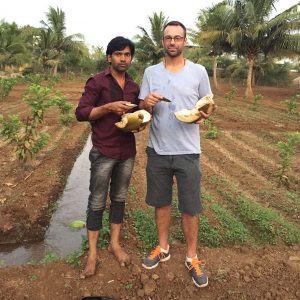 Here I am with Varadaraj eating a coconut. He showed me the land he just bought. He plans on moving his family and bronze workshop there and to grow his food as well!
Here I am with Varadaraj eating a coconut. He showed me the land he just bought. He plans on moving his family and bronze workshop there and to grow his food as well! Muthu with his son, Siva. I spend a lot of time in a small, dusty room with them looking at bronzes and going over our plans together. Siva is always smiling!
Muthu with his son, Siva. I spend a lot of time in a small, dusty room with them looking at bronzes and going over our plans together. Siva is always smiling!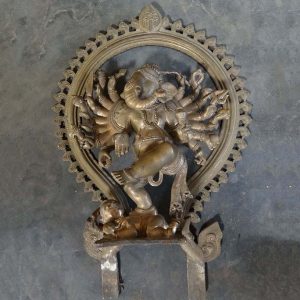 Here is a Dancing Ganesh with many arms! You can see how the statue is made in one casting without the base. For bronze statues, the base is always cast separately and joined together afterwards.
Here is a Dancing Ganesh with many arms! You can see how the statue is made in one casting without the base. For bronze statues, the base is always cast separately and joined together afterwards.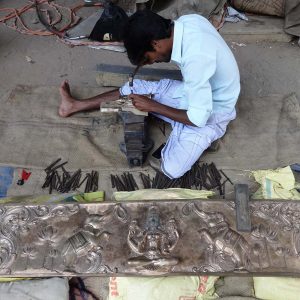 A carver sits working on a small Balaji statue with all the different chisels laying besides him. Another of his creations, a bronze panel of Gaja Lakshmi lays beside him.
A carver sits working on a small Balaji statue with all the different chisels laying besides him. Another of his creations, a bronze panel of Gaja Lakshmi lays beside him.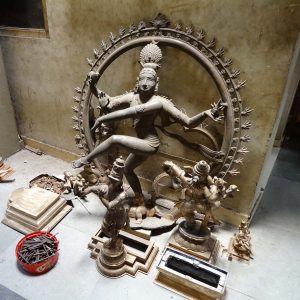 Its scenes like this that have made me fall in love with India. The muted tones of the bronze with the sunlight filtering through just gives that extra sense of magic to these incredible creations of divinity!
Its scenes like this that have made me fall in love with India. The muted tones of the bronze with the sunlight filtering through just gives that extra sense of magic to these incredible creations of divinity!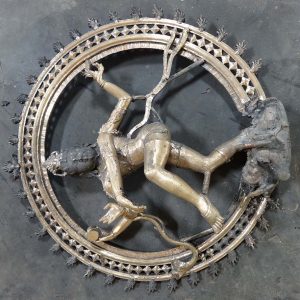 A 4 foot Nataraja statue being created. You can see the chisel marks all over the body of the statue. Also the extra bridge of metal over the length of his nose so the extra metal can be shaved down by the master artist who carves the finer details.
A 4 foot Nataraja statue being created. You can see the chisel marks all over the body of the statue. Also the extra bridge of metal over the length of his nose so the extra metal can be shaved down by the master artist who carves the finer details. I commissioned this dancing Shiva with Parvati set in 2015. Here Shiva is just after casting. You can see the nails the artists use to keep the earthen mold in place during the casting process to maintain the statues integrity
I commissioned this dancing Shiva with Parvati set in 2015. Here Shiva is just after casting. You can see the nails the artists use to keep the earthen mold in place during the casting process to maintain the statues integrity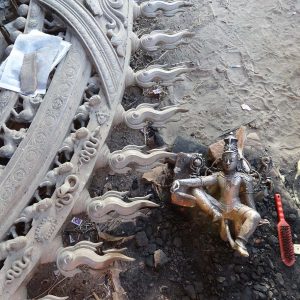 Bronze Vishnu statue that has just been cleaned after casting next to the flames of the 24 foot tall Nataraja statue
Bronze Vishnu statue that has just been cleaned after casting next to the flames of the 24 foot tall Nataraja statue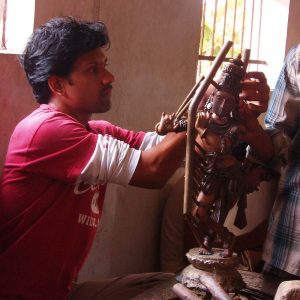 The extra wax tubes are used as tunnels for the rivers of molten bronze to funnel into the actual statue of Krishna.
The extra wax tubes are used as tunnels for the rivers of molten bronze to funnel into the actual statue of Krishna.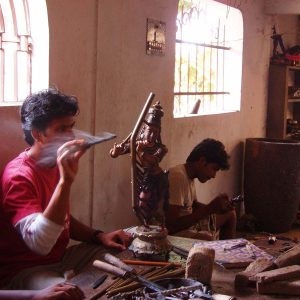 Varadaraj making the wax mold for gopal Krishna. He uses the hot stick to melt the wax.
Varadaraj making the wax mold for gopal Krishna. He uses the hot stick to melt the wax. The wax model for the reproduction for the Ganesh in the Cleveland Museum of Art.
The wax model for the reproduction for the Ganesh in the Cleveland Museum of Art.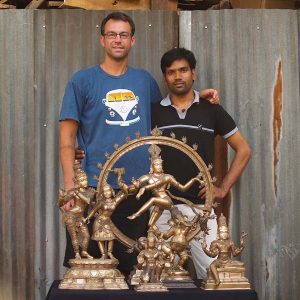 Varadaraj and I with some of the statues he made for Lotus Sculpture. We have known each other and been freinds since the starts of both of our businesses. He is the best bronze artisans in South India!
Varadaraj and I with some of the statues he made for Lotus Sculpture. We have known each other and been freinds since the starts of both of our businesses. He is the best bronze artisans in South India!